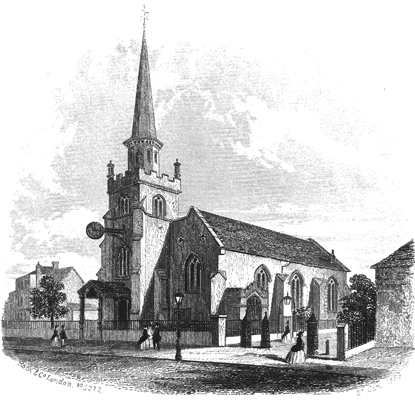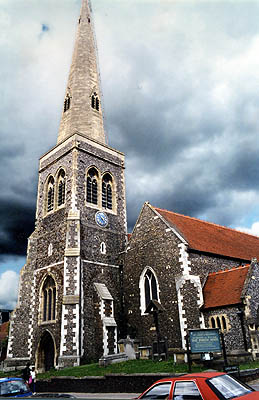 |
 |
|||
|
Though mostly a Victorian building, old parts of St. Giles' Church in Reading do still remain. The south and west walls are quite ancient, and in the south wall are the remains of a holy water stoup and two piscinae, one being of Norman and the other of early English architecture. Shortly before 1191, when it was given to Reading Abbey, the first St. Giles' Church was built alongside the main road into town from the south. Flooding of the River Kennet in winter had meant that many of the congregation of St. Mary's could not reach the church to receive mass, so this building was erected to serve them. The little chapel was made a proper parish church by 1200. St. Giles is the patron saint of beggars and cripples, and so churches dedicated to him are often built on the edge of towns where such people were banished by society. However, he is also the patron of lepers, so St. Giles' in Reading may have been the location of the Abbey's leper hospital recorded to have been somewhere within the town's borders. In Medieval times there were four holy images, probably small statues, kept in the church representing SS. Christopher, Mary, John and Giles. They must have been popular with pilgrims on their way to the Abbey from all over Southern England. The church then had two altars and two organs, all of which were removed at the Reformation. There was also formerly a sanctuary, south of Crown Street, that was attached to the church. In accordance with one of the building's ancient privileges, malefactors of every description could escape the officers of the law there for forty days. After this time, if they wished to avoid arrest, they had to admit their guilt and then leave forthwith for the coast. Wearing sackcloth and carrying a wooden cross, they had to stay on the highway and flee abroad within three days. One interesting relic that survives from these pre-Reformation days is a memorial brass, which, in addition to a male and female figure, has this inscription: "Of your charity pray for the souls of John Bowyer of Reading, tanner, and Joan his wife, which John deceased the 11th day of April ye year of Our Lord 1521. On whose souls, Jesus have mercy, Amen." There were once others, now lost:, to Richard Stottesbury (fl. 1411) and Nicholas Nicholas (d. 1514). St. Giles' Church may have been largely rebuilt at about the time the last memorial was erected, for the first entries in the parish books are dated 1518. Between 1520 and 1533, John Einion was the Vicar of St, Giles'. Three years after his resignation, he obtained a copy of Aske's Manifesto outlining the demands of the rebellious Pilgrimage of Grace from the servant of Sir William Essex of Lambourn Place. He then passed copies to his successor at St. Giles and other priests in the town. The 'pilgrims' were hoping to persuade King Henry VIII to change his church reforming ways, but the monarch was in no mood to backtrack, and distributing the manifesto was seen as treason. Einion was later arrested, as chief advisor to the Abbot of Reading who refused to surrender his abbey to the Royal authorities. Both men were executed outside the Abbey Gateway and some centuries later, Einion was beatified by the Catholic Church. He has a modern memorial in St. Giles'. The Reformation continued and the church accounts, of the 1540s to 60s, show that the parish ejected their stone altar and purchased instead a wooden communion table, along with an English Bible and a Book of Common Prayer. They dismantled the medieval churchyard preaching cross and whitewashed the beautiful wall paintings from the same era. The arches and columns of the church were rebuilt in 1628, and the church itself was repaired in 1635. During the Siege of Reading by the Parliamentary troops seven years later, the Royalists mounted a cannon on the tower. This compelled the besiegers to bring a battery to bear upon it, which soon destroyed the spire and reduced the tower to ruins. When the country again became settled, the tower was repaired in 1654, but the spire was not replaced for over a hundred years. The churchyard was used for the burial of many soldiers during the siege, as well as their wives and children. Twenty-three plague victims joined them in 1665, and further Irish and Dutch soldiers after the Glorious Revolution's Battle of Broad Street. The church suffered considerable Georgian rebuilding, starting after the roof, tower, clock and porches were damaged in the 'Great Storm' of 1704. In 1784, the church attracted large congregations to hear the stirring discourses of the evangelist, the Hon & Rev William Bromley Cadogan (the son of Lord Cadogan of Caversham Park), and it was to accommodate the crowds that low galleries were erected, one in the south aisle, the other at the entrance of the chancel, by subscription amounting to £456 as well as charitable donations. However, Cadogan's successor was far from enthusiastic in his sermons and a large portion of the congregation left to build St. Mary's Congregational Chapel in Castle Street.. A slender copper covered octagonal wooden spire, 70ft tall, was erected on top of the tower in 1790 at a cost of £573-19s. The bells were recast at the same time.
The Victorians, however, considered Old St. Giles' "not only unsightly but inconvenient". Thanks to the devoted energy of the Rev. C. H. Travers, the then vicar, all this was swept away and a new handsome, spacious, though somewhat sterile, structure, with a tower surmounted by a beautiful stone octagonal spire, was erected at a cost of £10,000. It features some attractive arts and crafts mosaicesque murals either side of the altar and an appealing pelican-in-her-piety lectern. A few ancient monuments survive. One is by Peter Scheemakers, although generally they are rather uninteresting collection of mural tablets, mostly to former vicars. Of well known Reading families, there is a single monument to one of the Watlingtons and another to a Simeon, plus a number of plaques to the Simonds family of brewery fame. There was once a hatchment to the Hon. Rev. Cadogan, but this disappeared during the Victorian restoration. This is not the official St. Giles' Church website. Please do NOT mail me about use of the church. Visit the C of E's Church Near You website instead.
|
|||
| © Nash Ford Publishing 2003;Revised 2015. All Rights Reserved. | ||||





 Reading
Reading